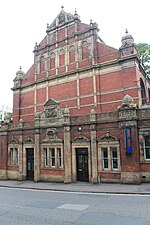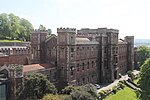Brandon Hill, Bristol

Brandon Hill, also known as St Brandon's Hill, is a hill close to Bristol city centre, between the districts of Clifton and Hotwells, in south west England. At the summit is the Cabot Tower, opened in 1897 to commemorate the 400th anniversary of John Cabot's voyage from Bristol to Newfoundland in 1497. The upper part of the hill is a steep park, Brandon Hill Park, divided into informal gardens, a small nature reserve and open grassland. The two-hectare nature reserve has been run since 1980 by the Avon Wildlife Trust who have their headquarters beside the park. The wildflower meadow includes ox-eye daisies, yellow rattle and knapweed. A pond provides a breeding site for frogs, toads and smooth newts. The butterfly garden supplies food for caterpillars and many kinds of butterflies. Birds such as jay, bullfinch and blackcap are seen in the reserve. Native trees and shrubs have been planted, and the meadow is cut for hay in July.The lower slopes of the hill were developed in the 18th and 19th centuries. St George's Church lies on Great George Street on the eastern slope, Berkeley Square is on the northern edge, and the school buildings of Queen Elizabeth's Hospital are on the western side.
Excerpt from the Wikipedia article Brandon Hill, Bristol (License: CC BY-SA 3.0, Authors, Images).Brandon Hill, Bristol
Geographical coordinates (GPS) Nearby PlacesShow on map
Geographical coordinates (GPS)
| Latitude | Longitude |
|---|---|
| N 51.45291 ° | E -2.6068 ° |









